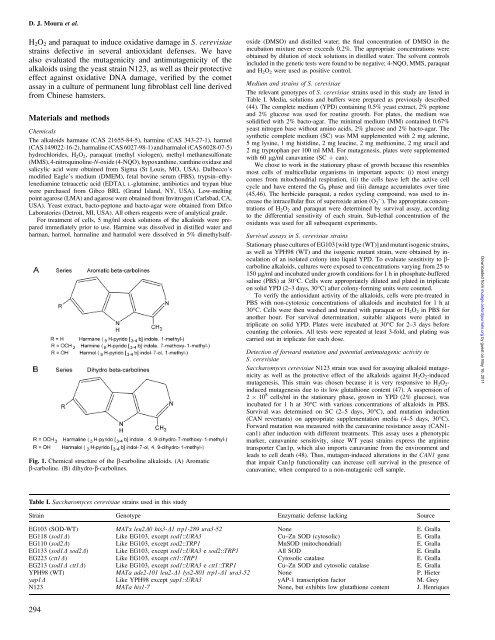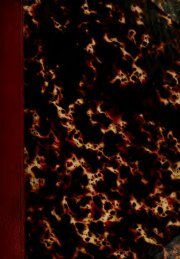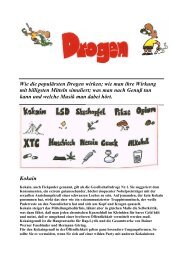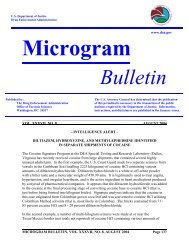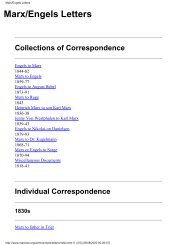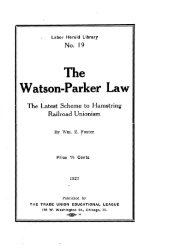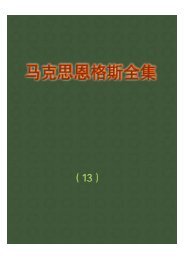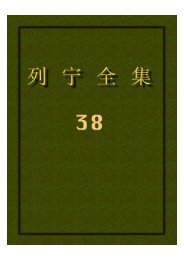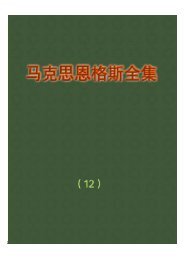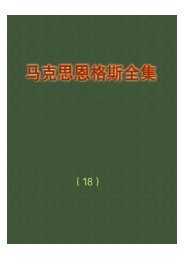MOURA Dinara Jaqueline et al.
MOURA Dinara Jaqueline et al.
MOURA Dinara Jaqueline et al.
Create successful ePaper yourself
Turn your PDF publications into a flip-book with our unique Google optimized e-Paper software.
D. J. Moura <strong>et</strong> <strong>al</strong>.<br />
H2O2 and paraquat to induce oxidative damage in S. cerevisiae<br />
strains defective in sever<strong>al</strong> antioxidant defenses. We have<br />
<strong>al</strong>so ev<strong>al</strong>uated the mutagenicity and antimutagenicity of the<br />
<strong>al</strong>k<strong>al</strong>oids using the yeast strain N123, as well as their protective<br />
effect against oxidative DNA damage, verified by the com<strong>et</strong><br />
assay in a culture of permanent lung fibroblast cell line derived<br />
from Chinese hamsters.<br />
Materi<strong>al</strong>s and m<strong>et</strong>hods<br />
Chemic<strong>al</strong>s<br />
The <strong>al</strong>k<strong>al</strong>oids harmane (CAS 21655-84-5), harmine (CAS 343-27-1), harmol<br />
(CAS 149022-16-2), harm<strong>al</strong>ine (CAS 6027-98-1) and harm<strong>al</strong>ol (CAS 6028-07-5)<br />
hydrochlorides, H2O2, paraquat (m<strong>et</strong>hyl viologen), m<strong>et</strong>hyl m<strong>et</strong>hanesulfonate<br />
(MMS), 4-nitroquinoline-N-oxide (4-NQO), hypoxanthine, xanthine oxidase and<br />
s<strong>al</strong>icylic acid were obtained from Sigma (St Louis, MO, USA). Dulbecco’s<br />
modified Eagle’s medium (DMEM), f<strong>et</strong><strong>al</strong> bovine serum (FBS), trypsin–<strong>et</strong>hylenediamine<br />
t<strong>et</strong>raac<strong>et</strong>ic acid (EDTA), L-glutamine, antibiotics and trypan blue<br />
were purchased from Gibco BRL (Grand Island, NY, USA). Low-melting<br />
point agarose (LMA) and agarose were obtained from Invitrogen (Carlsbad, CA,<br />
USA). Yeast extract, bacto-peptone and bacto-agar were obtained from Difco<br />
Laboratories (D<strong>et</strong>roit, MI, USA). All others reagents were of an<strong>al</strong>ytic<strong>al</strong> grade.<br />
For treatment of cells, 5 mg/ml stock solutions of the <strong>al</strong>k<strong>al</strong>oids were prepared<br />
immediately prior to use. Harmine was dissolved in distilled water and<br />
harman, harmol, harm<strong>al</strong>ine and harm<strong>al</strong>ol were dissolved in 5% dim<strong>et</strong>hylsulf-<br />
Fig. 1. Chemic<strong>al</strong> structure of the b-carboline <strong>al</strong>k<strong>al</strong>oids. (A) Aromatic<br />
b-carboline. (B) dihydro-b-carbolines.<br />
Table I. Saccharomyces cerevisiae strains used in this study<br />
oxide (DMSO) and distilled water; the fin<strong>al</strong> concentration of DMSO in the<br />
incubation mixture never exceeds 0.2%. The appropriate concentrations were<br />
obtained by dilution of stock solutions in distilled water. The solvent controls<br />
included in the gen<strong>et</strong>ic tests were found to be negative; 4-NQO, MMS, paraquat<br />
and H2O2 were used as positive control.<br />
Medium and strains of S. cerevisiae<br />
The relevant genotypes of S. cerevisiae strains used in this study are listed in<br />
Table I. Media, solutions and buffers were prepared as previously described<br />
(44). The compl<strong>et</strong>e medium (YPD) containing 0.5% yeast extract, 2% peptone<br />
and 2% glucose was used for routine growth. For plates, the medium was<br />
solidified with 2% bacto-agar. The minim<strong>al</strong> medium (MM) contained 0.67%<br />
yeast nitrogen base without amino acids, 2% glucose and 2% bacto-agar. The<br />
synth<strong>et</strong>ic compl<strong>et</strong>e medium (SC) was MM supplemented with 2 mg adenine,<br />
5 mg lysine, 1 mg histidine, 2 mg leucine, 2 mg m<strong>et</strong>hionine, 2 mg uracil and<br />
2 mg tryptophan per 100 ml MM. For mutagenesis, plates were supplemented<br />
with 60 lg/ml canavanine (SC þ can).<br />
We chose to work in the stationary phase of growth because this resembles<br />
most cells of multicellular organisms in important aspects: (i) most energy<br />
comes from mitochondri<strong>al</strong> respiration, (ii) the cells have left the active cell<br />
cycle and have entered the G 0 phase and (iii) damage accumulates over time<br />
(45,46). The herbicide paraquat, a redox cycling compound, was used to increase<br />
the intracellular flux of superoxide anion (O2 –. ). The appropriate concentrations<br />
of H2O2 and paraquat were d<strong>et</strong>ermined by surviv<strong>al</strong> assay, according<br />
to the differenti<strong>al</strong> sensitivity of each strain. Sub-l<strong>et</strong>h<strong>al</strong> concentration of the<br />
oxidants was used for <strong>al</strong>l subsequent experiments.<br />
Surviv<strong>al</strong> assays in S. cerevisiae strains<br />
Stationary phase cultures of EG103 [wild type (WT)] and mutant isogenic strains,<br />
as well as YPH98 (WT) and the isogenic mutant strain, were obtained by inoculation<br />
of an isolated colony into liquid YPD. To ev<strong>al</strong>uate sensitivity to bcarboline<br />
<strong>al</strong>k<strong>al</strong>oids, cultures were exposed to concentrations varying from 25 to<br />
150 lg/ml and incubated under growth conditions for 1 h in phosphate-buffered<br />
s<strong>al</strong>ine (PBS) at 30°C. Cells were appropriately diluted and plated in triplicate<br />
on solid YPD (2–3 days, 30°C) after colony-forming units were counted.<br />
To verify the antioxidant activity of the <strong>al</strong>k<strong>al</strong>oids, cells were pre-treated in<br />
PBS with non-cytotoxic concentrations of <strong>al</strong>k<strong>al</strong>oids and incubated for 1 h at<br />
30°C. Cells were then washed and treated with paraquat or H2O2 in PBS for<br />
another hour. For surviv<strong>al</strong> d<strong>et</strong>ermination, suitable <strong>al</strong>iquots were plated in<br />
triplicate on solid YPD. Plates were incubated at 30°C for 2–3 days before<br />
counting the colonies. All tests were repeated at least 3-fold, and plating was<br />
carried out in triplicate for each dose.<br />
D<strong>et</strong>ection of forward mutation and potenti<strong>al</strong> antimutagenic activity in<br />
S. cerevisiae<br />
Saccharomyces cerevisiae N123 strain was used for assaying <strong>al</strong>k<strong>al</strong>oid mutagenicity<br />
as well as the protective effect of the <strong>al</strong>k<strong>al</strong>oids against H 2O 2-induced<br />
mutagenesis. This strain was chosen because it is very responsive to H 2O 2induced<br />
mutagenesis due to its low glutathione content (47). A suspension of<br />
2 10 8 cells/ml in the stationary phase, grown in YPD (2% glucose), was<br />
incubated for 1 h at 30°C with various concentrations of <strong>al</strong>k<strong>al</strong>oids in PBS.<br />
Surviv<strong>al</strong> was d<strong>et</strong>ermined on SC (2–5 days, 30°C), and mutation induction<br />
(CAN revertants) on appropriate supplementation media (4–5 days, 30°C).<br />
Forward mutation was measured with the canavanine resistance assay (CAN1can1)<br />
after induction with different treatments. This assay uses a phenotypic<br />
marker, canavanine sensitivity, since WT yeast strains express the arginine<br />
transporter Can1p, which <strong>al</strong>so imports canavanine from the environment and<br />
leads to cell death (48). Thus, mutagen-induced <strong>al</strong>terations in the CAN1 gene<br />
that impair Can1p function<strong>al</strong>ity can increase cell surviv<strong>al</strong> in the presence of<br />
canavanine, when compared to a non-mutagenic cell sample.<br />
Strain Genotype Enzymatic defense lacking Source<br />
EG103 (SOD-WT) MATa leu2D0 his3-D1 trp1-289 ura3-52 None E. Gr<strong>al</strong>la<br />
EG118 (sod1D) Like EG103, except sod1::URA3 Cu–Zn SOD (cytosolic) E. Gr<strong>al</strong>la<br />
EG110 (sod2D) Like EG103, except sod2::TRP1 MnSOD (mitochondri<strong>al</strong>) E. Gr<strong>al</strong>la<br />
EG133 (sod1D sod2D) Like EG103, except sod1::URA3 e sod2::TRP1 All SOD E. Gr<strong>al</strong>la<br />
EG223 (ctt1D) Like EG103, except ctt1::TRP1 Cytosolic cat<strong>al</strong>ase E. Gr<strong>al</strong>la<br />
EG213 (sod1D ctt1D) Like EG103, except sod1::URA3 e ctt1::TRP1 Cu–Zn SOD and cytosolic cat<strong>al</strong>ase E. Gr<strong>al</strong>la<br />
YPH98 (WT) MATa ade2-101 leu2-D1 lys2-801 trp1-D1 ura3-52 None P. Hi<strong>et</strong>er<br />
yap1D Like YPH98 except yap1::URA3 yAP-1 transcription factor M. Grey<br />
N123 MATa his1-7 None, but exhibits low glutathione content J. Henriques<br />
294<br />
Downloaded from<br />
mutage.oxfordjourn<strong>al</strong>s.org by guest on May 16, 2011


